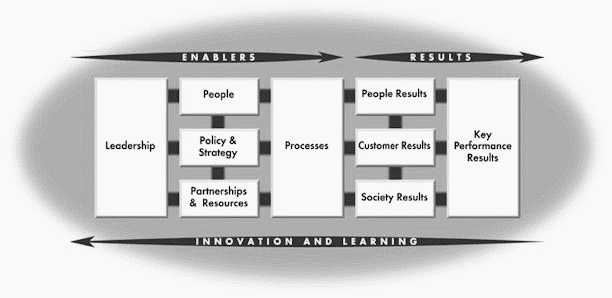Table of contents
Total Quality Management
and Reinventing Government
Deming's 14 Principles
Table of contents |
The EFQM Excellence Model | HOME |
back to
Total Quality Management and Reinventing Government |
go on to:
Deming's 14 Principles |
The need for a model
Regardless of sector, size, structure or maturity, to be successful, organisations need to establish an appropriate management system. The EFQM Excellence Model is a practical tool to help organisations do this by measuring where they are on the path to Excellence; helping them understand the gaps; and then stimulating solutions. The EFQM is committed to researching and updating the Model with the inputs of tested good practices from thousands of organisations both within and outside of Europe. In this way we ensure the model remains dynamic and in line with current management thinking.
The Fundamental Concepts of Excellence
The EFOM Model is a non-prescriptive framework that recognises there are many approaches to achieving sustainable excellence. Within this non-prescriptive approach there are some Fundamental Concepts which underpin the EFQM Model. These are expressed below.
There is no significance intended in the order of the concepts. The list is not meant to be exhaustive and they will change as excellent organisations develop and improve.
Results Orientation
Excellence is dependent upon balancing and satisfying the needs of all relevant stakeholders (this includes the people employed, customers, suppliers and society in general as well as those with financial interests in the organisation).
Customer Focus
The customer is the final arbiter of product and service quality and customer loyalty, retention and market share gain are best optimised through a clear focus on the needs of current and potential customers.
Leadership & Constancy of Purpose
The behaviour of our organisation's leaders creates a clarity and unity of purpose within the organisation and an environment in which the organisation and its people can excel.
Management by Processes & Facts
Organisations perform more effectively when all inter-related activities are understood and systematically managed and decisions concerning current operations and planned. improvements are made using reliable information that includes stakeholder perceptions.
People Development & Involvement
The full potential of an organisation's people is best released through shared values and a culture of trust and empowerment, which encourages the involvement of everyone.
Continuous Learning, Innovation & Improvement
Organisational performance is maximised when it is based on the management and sharing of knowledge within a culture of continuous learning, innovation and improvement.
Partnership Development
An organisation works more effectively when it has mutually beneficial relationships, built on trust, sharing of knowledge and integration, with its Partners.
Public Responsibilitry
The long-term interest of the organisation
and its people are best served by adopting an ethical approach and exceeding
the expectations and regulations of the community at large.
Overview of the EFQM Excellence Model
The EFQM Excellence Model is a non-prescriptive framework based on nine criteria. Five of these are "Enablers" and four are "Results".The "Enabler" criteria cover what an organisation does. The "Results" criteria cover what an organisation achieves. "Results" ore caused by "Enablers".
The Model, which recognises there are many approaches to achieving sustainable excellence in all aspects of performance, is based on the premise that:
Excellent results with respect to Performance, Customers, People and Society are achieved through Partnerships and Resources, and Processes.
The EFQM Model is presented in diagrammatic form below:

The arrows emphasise the dynamic nature of the model. They show innovation and learning helping to improve enablers that in turn lead to improved results.
Model contents structure
The Model's 9 boxes, shown above, represent the criteria against which to assess an organisation's progress towards excellence. Each of the nine criteria has a definition, which explains the high level meaning of that criterion.
To develop the high level meaning further each criterion is supported by a number of subcriteria. Sub-criteria pose a number of questions that should be considered in the course of an assessment.
Click on a criterion in the image of the model above to get subcriterion level descriptions.
Finally below each sub-criterion are lists of possible areas to address. The areas to address are not mandatory nor are they exhaustive lists but are intended to further exemplify the meaning of the sub-criterion.
Model Helpline
A Helpline is available to answer questions on the EFQM Excellence Model.
This can be reached by email on model.info(at)efqm.org
Table of contents |
The EFQM Excellence Model | HOME |
back to
Total Quality Management and Reinventing Government |
go on to:
Deming's 14 Principles |